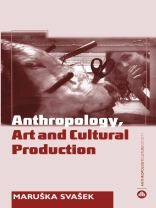This book provides an introduction to anthropological perspectives on art.
Svasek defines art as a social process. We study not only the artefacts themselves and the values attributed to them, but also the process of production and its wider context.
Providing a critical overview of various anthropological theories of art, Svasek offers a new perspective which centres on the analysis of commoditisation, aestheticisation and object agency. She explores the process of collecting and exhibiting art works and how this relates to art’s production, distribution and consumption in an increasingly global market.
The book outlines the significance of art and aesthetics in everyday life, and examines the shifting boundaries between art and other categories such as kitsch, souvenirs, propaganda and pornography.
Finally, Svasek argues for an anthropological perspective that links the production and consumption of artefacts to political, religious and other cultural processes.
Ideal as a teaching text, this book gives a detailed overview of themes that are central to the fields of art history, art sociology and cultural studies.
Inhaltsverzeichnis
1. Art: Anthropological Perspectives
2. Objects, Representation, and Power
3. The Politics of Museum Display
4. Theorising Art: from Evolutionism to Structuralism
5. Theorising Art: from Post-Structuralism to Postmodernism and Beyond
6. Art, Society, and Culture
7. Art Production, Distribution, Consumption
8. Art and its Boundaries
9. Conclusion
Über den Autor
Maruska Svasek is Reader in Anthropology at the School of History and Anthropology at Queens University, Belfast. She is the author of Mixed Emotions (Berg 2005), Anthropology, Art and Cultural Production (Pluto 2007), Emotions and Human Mobility (Routledge 2012) and Moving Subjects, Moving Objects (Berghahn 2012). She is co-editor of the Berghahn series Material Mediations: People and Things in a World of Movement.












